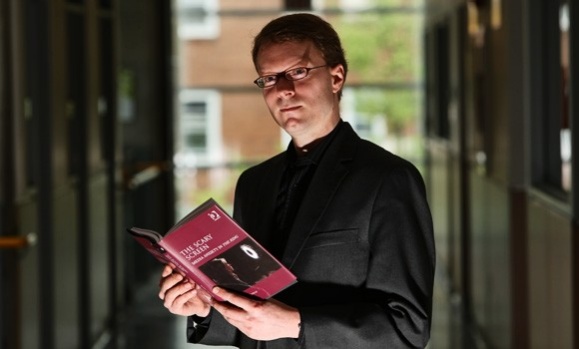When The Ring came out in 2002, most people watched it once, then allowed it to fade from mind so their heart rates could return to normal. Not so Dal professor Anthony Enns.
His fascination with The Ring not only lasted, but recently culminated in his article āThe Horror of Media: Technology and Spirituality in the Ringu films,ā published in collection The Scary Screen (ed. Kristen Lacefield, London: Ashgate Publishing, 2010).
āMy essay is on the Japanese filmsā¦ and the history of Japanese parapsychology,ā explains Dr. Enns, assistant professor of English. āMy dissertation was on spiritualism and psychical researchā¦ I actually knew about the history before I saw the films.ā
Scary sources
When he first viewed the Japanese film The Ring is based upon, Ringu (Hideo Nakata, 1998) Dr. Enns was struck by its similarities to the story of historical Japanese parapsychological researcher Tomokichi Fukurai. āAs soon as I saw the Japanese films, I knew that they were borrowing from this book,ā says Dr. Enns. āThis (the film) is based loosely on an actual press conference that Fukurai held in 1910.ā
Many North American viewers missed the homage by watching only director Gore Verbinskiās take: āAll of this history is omitted from the American remakeā¦ I think thatās simply because international viewers would not recognize the references to Fukurai.ā
Not only does Dr. Enns view Ringu as being quietly inspired by Fukuraiās work, he sees Fukurai himself as subtly resisting the 20th century domination of Western modernization over local Japanese traditions.
āPsychology, as a discipline, was imported from the Westā¦ Fukurai was trying to counteract this tendency. He wasnāt embracing the Western version of psychology that he was āsupposed to,āā but instead, āan older tradition that didnāt fit into Western notions of rationality.ā Fukaraiās work in the occult brought him into association with Japanese mediums such as Chizuko Mifune and Sadako Takahashi, women who claimed talents of clairvoyance and nengraphy (the ability to influence photographs). Fukuraiās publication of his theories met with widespread ridicule. āIn the film,ā says Dr. Enns, āThey incorporate the psychicās suicide, nengraphyā¦ although the shift is from photography onto videotapes.ā
While he enjoyed Ringu, Enns doesnāt think it helped Fukuraiās image. āI do think thereās something very conservative, ultimately, about the narrative. Theyāre betraying what Fukurai was trying to doā¦ suddenly psychical research is something to be afraid of, itās something to be feared,ā he explains, though he takes care to add ābut I think theyāre great as films.ā The Japanese film was based on Koji Suzukiās novel Ringu, and according to Dr. Enns, print narratives tend to take a hard tack on the occult possibilities inherent in new technologies. āNew technologies always have urban legends: ghost photographs, phonograph recordings of voices of the deadā¦ the history is fascinatingā¦ these narratives are incorporated into print narratives through the mode of the gothic. Print narratives are always trying to remind us that other media are dangerous.ā
Fascinating reading
Itās also no coincidence that the terrifying evil at the heart of the different versions of Ringu is always female: early spiritualism had feminist undertones. āFor a lot of women in the mid-19th century, being a medium was the only way to get work.ā Women, after all, were the telephone operators, and a āspiritual medium was a switchboard for the dead.ā
Given Dr. Ennsā intense and sustained research on otherworldly interactions, does he care to weigh in? Do ghosts, mediums, clairvoyants exist? Were Fukurai and his mediums spurned visionaries, or mere tricksters?
āI donāt know, and I donāt think it matters,ā says Dr. Enns. āItās very possible that the mediums were conning himā¦ I donāt think that he himself had a motive for trying to trick people.ā And why societyās eternal fascination with the supernatural and horrific, from Fukuraiās era to our own? Are we just a morbid bunch? Dr. Enns gives us a little more credit. āI donāt believe in spirits, but with these new technologiesā¦ we are surrounded by the dead all the time in a way that people from the 18th century wouldnāt have experienced.ā
If youāve seen Ringu, then, Dr. Ennsā article will prove fascinating reading material, and, if you havenāt, it comes recommended by a reliable source. Throw some popcorn in the microwave, and donāt forget to leave the lights on.

